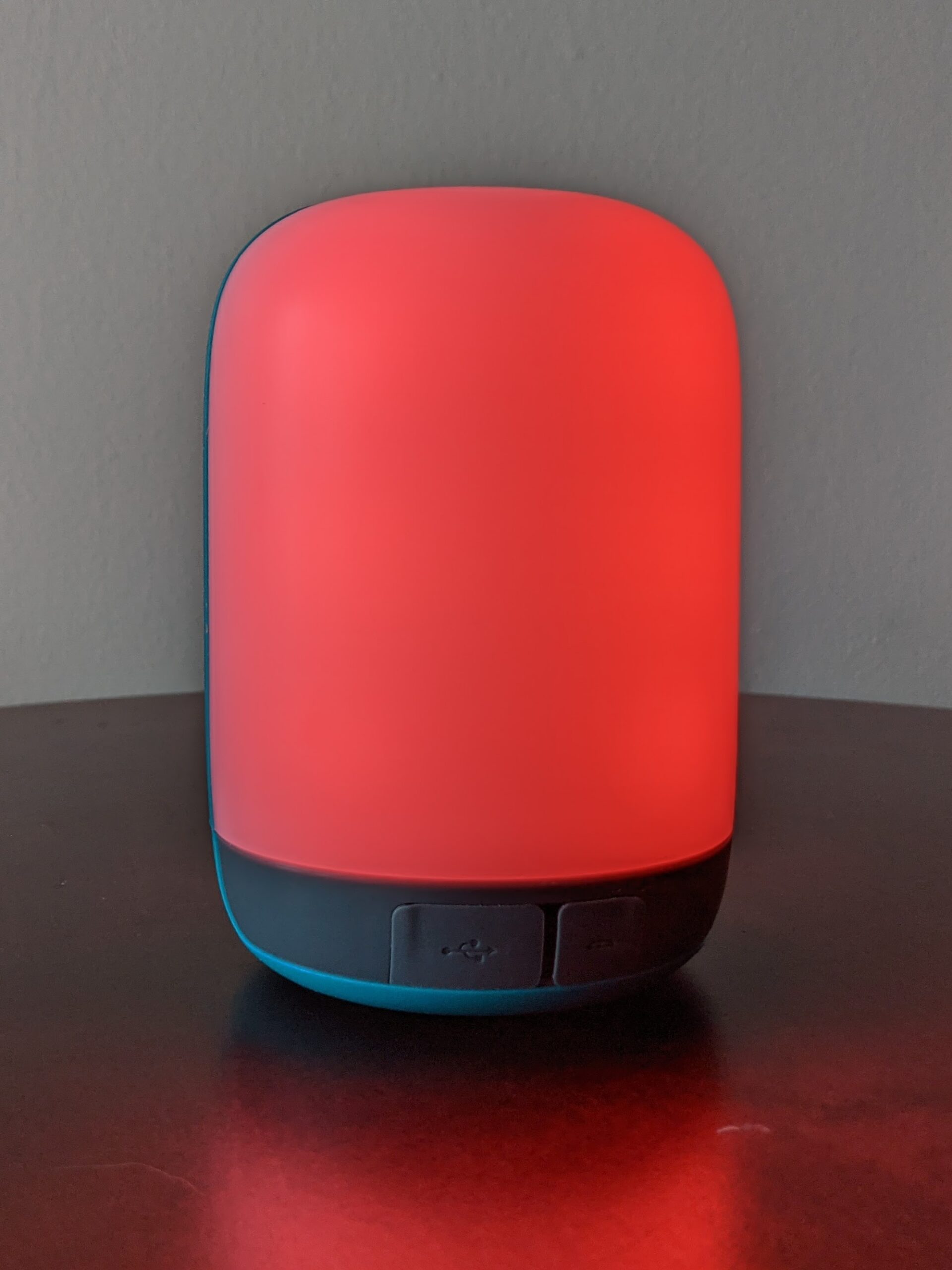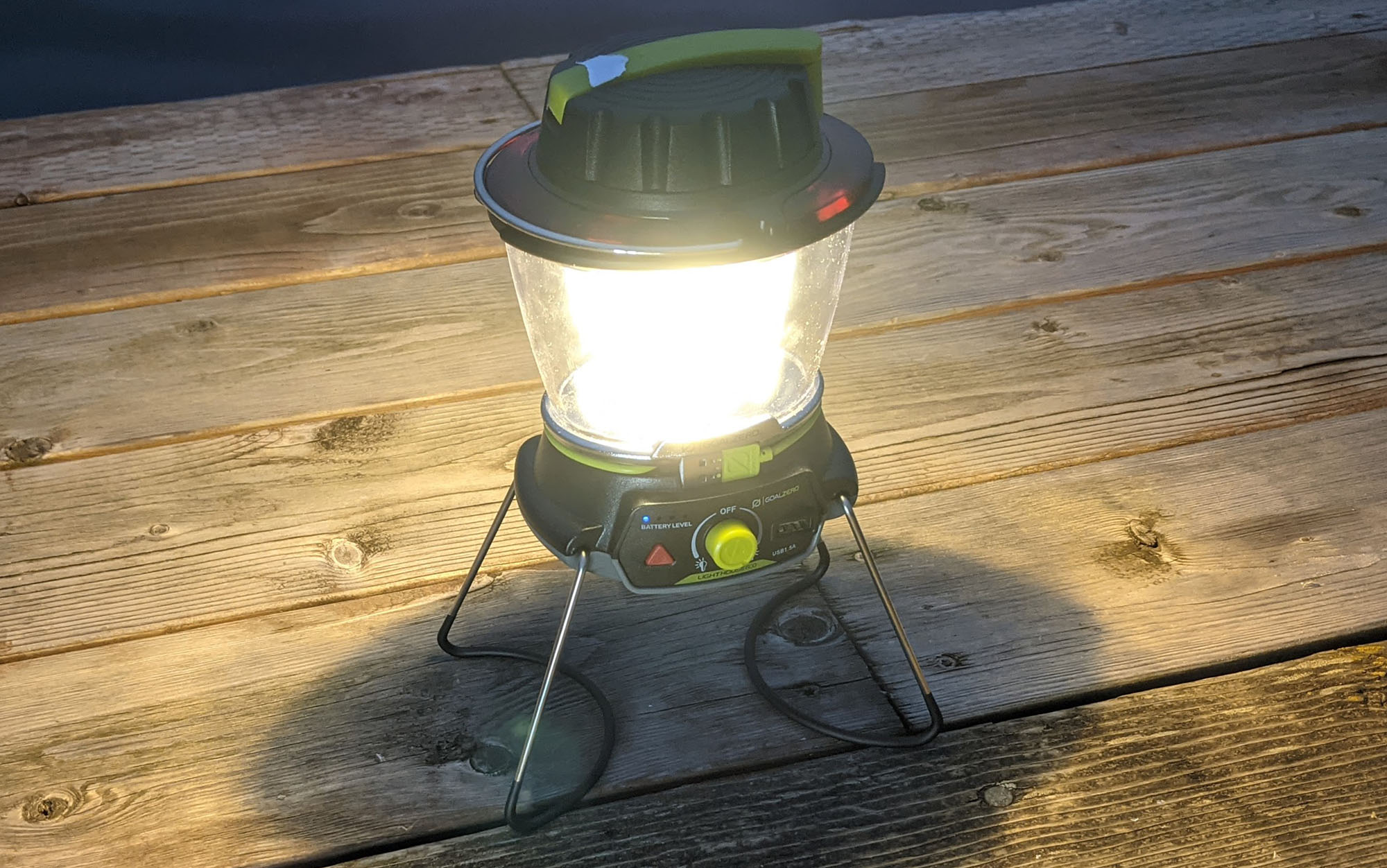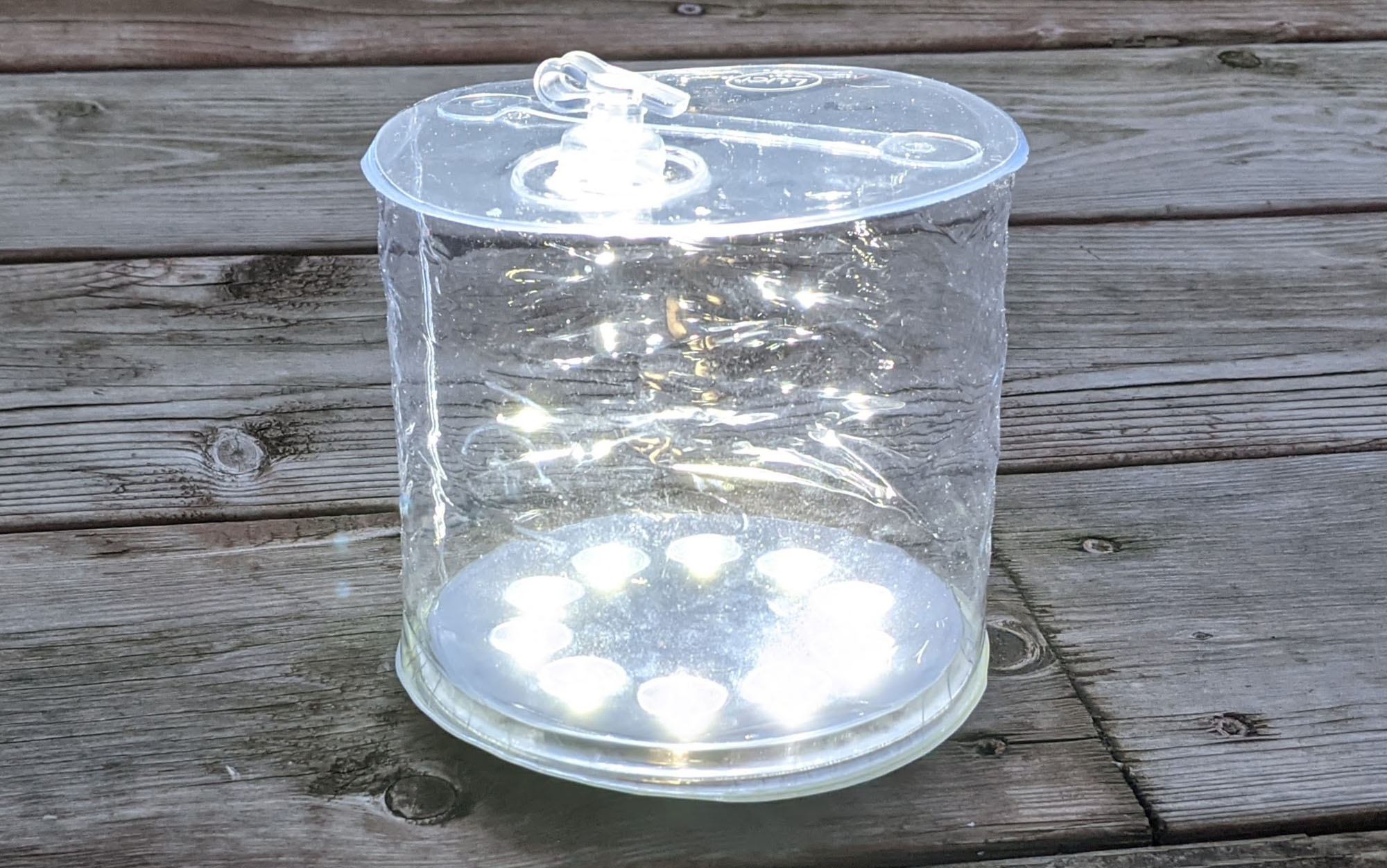We may earn revenue from the products available on this page and participate in affiliate programs. Learn More ›
Published Feb 18, 2023 12:00 PM
Whether you’re organizing a post-dinner card game or setting out all the fixings for some evening s’mores, a camping lantern is a must for long weekends in the outdoors. But from bright-white LEDs to the warm glow of a single mantle lantern to a string of solar-powered lamps strung up over a picnic table, there is a surprising amount of variation in what is available. To help you choose, I tested some of the best camping lanterns from top outdoor manufacturers to compare side-by-side.
| Camping Lantern | Price | Power Source | Bulb | Lumens | Waterproof | Height | Burn Time |
| MPOWERD Luci Outdoor 2.0 | $30 | 1,000 mAh battery, recharges via attached solar panel | Cool white LED | 75 | IP67 | 5 inches (inflated); 1 inch (deflated) | 8 hours |
| Coleman Northstar Propane | $70 | Propane, single mantle | Single mantle | 1500 | N/A | 12 inches | – |
| BioLite AlpenGlow 500 | $80 | 6,400 mAh battery, recharges via micro USB | ChromaReal broad spectrum LED | 500 | IPX4 | 5.5 inches | 12 hours |
| Black Diamond Apollo | $70 | 2,600 mAh, recharges via micro USB or 3 AA batteries | QuadPower LED | 250 | IPX4 | 8.5 inches (unfolded); 4.5 inches (folded) | 7 hours |
| Goal Zero Lighthouse 600 | $70 | 5,200 mAh, recharges via attached USB cord | LED | 600 | N/A | 9.5 inches (unfolded); 6 inches (folded) | 3 hours |
Testing the Best Camping Lanterns
I evaluated the best camping lanterns on the level of light provided, including its brightness, quality, and reach as well as how long the lantern lasted at full power. The exception to this was the Coleman Northstar, where the mantle that came with the lantern broke during setup—at this point it was removed from testing.
While I have noted in my review when a lantern can also serve as a power bank, the size of their batteries mean that most campers will end up using a power bank to recharge their camping lantern, rather than the other way around. I also took cost into consideration, including both the upfront cost of the camping lantern and the recurring cost to power it.
The Best Camping Lanterns: Reviews & Recommendations
Best Overall: Black Diamond Apollo
Key Features
- Lasted seven hours at full brightness
- Lumens: 250
- Height: 8.5 inches (unfolded); 4.5 inches (folded)
- Rated for IPX4 (water resistant to heavy rain)
Pros
- Very small packed size
- Light enough to bring on low-key backpacking trips
- Brighter than its lumen-rating would lead you to expect
- Water resistant in case you leave it out overnight
Cons
- White light is less pleasant than other models I looked at
With three foldable legs that extend down to double its body height, the Black Diamond Apollo was one of the most compact camping lanterns I looked at. Despite having the second-lowest lumen rating in my test, the Black Diamond Apollo’s light punched above its weight. Several individuals noted that it seemed as if this lantern was providing at least as much light coverage, if not more, than the higher-lumen LED models.


But what really stood out during testing was its battery life. While other batteries only lasted a few hours, this camping lantern was still going seven hours later in warm temperatures, meaning it has enough juice to get you through an evening around the picnic table (its IPX4 rating means it can also handle a little rain). And in the event it does still kick out while the night is young, you still have the option to plug in three AA batteries to keep it going.
While this model does have the option to recharge a secondary device directly from its internal battery (USB connection), it doesn’t quite have a large enough battery to make this a smart choice—bring a battery pack instead.
Most Versatile: Goal Zero Lighthouse 600
Key Features
- Lasted three hours at full brightness
- Lumens: 600
- Height: 9.5 inches (unfolded); 6 inches (folded)
- Not rated for water resistance
Pros
- Wonderful bright, warm light
- Option to provide power through a handcrank
Cons
- Attached USB cord could create long-term durability issues
- Battery only lasted three hours during testing.
- Uncovered outlets and attached charging cable likely to create issues if this is left out in the rain
If you’re looking to purchase a multi-purpose lantern for both camping adventures and at-home blackouts, then the Goal Zero Lighthouse 600 is a great option. Its warm light (no fancy color options here) most closely resembles the warm light of a traditional propane lantern—but without the hassle of finicky fuel sources.


In fact, it’s the Goal Zero’s approach to recharging that really stood out during testing. While other camping lanterns I looked at relied on a single power source (power outlet, solar, propane), the Goal Zero also included an optional handcrank, which during testing did indeed provide about 10 minutes of light for every one minute of crank, an especially useful feature if you end up leaving this lantern in the closet for years before an unexpected power outage hits.
Further, while I have some concerns about the long-term durabiliy of the attached recharge cord for the Lighthouse 600, I appreciated that Goal Zero correctly anticipated how likely I am to lose the Micro USB charging cables that came with both the BioLite AlpenGlow 500 and the Black Diamond Apollo. While there are still are a few other electronics in my household that use this Micro USB port, they are rapidly being replaced by the common USB-C.

Finally, while the Goal Zero Lighthouse 600 is not rated for waterproofness, it’s clear from looking at it that leaving it on the picnic table overnight when there is rain in the forecast is a terrible idea. In addition to the attached (and exposed) USB charging cable, there is also an exposed USB port, which can be used to recharge a device directly from the Lighthouse 600. I hope in future iterations of this device that Goal Zero provides a secure cover for the charging cable and removes the charging port entirely (realistically you’re going to be charging this camping lantern with a secondary power bank, given the size of its battery and max lumen output).
Best Budget: MPOWERD Luci Outdoor 2.0
Key Features
- Lasted eight hours at full power
- Lumens: 75
- Height: 1 inch (deflated); 5.5 inches (inflated)
- Rated for IP67 (waterproof for 30 minutes when submerged in 1 meter of freshwater)
Pros
- Super fun
- Essentially waterproof
- No additional parts required
Cons
- Not all that bright
- Cannot be recharged at night using an external battery pack
Does the MPOWERED Luci Outdoor 2.0 produce a significant amount of light? Not really. Does it charge quickly? Definitely not. But is it fun? Oh, yes.
While other of the LED lights in my test have a typical USB port for recharging, the Luci has only a simple solar panel element. While in my experience the solar panels attached to solar chargers are not usually worthy of the name, the one on the Luci works pretty well for what it is. Even under a cloudy February sky, the Luci was able to fully recharge during the day. While the light itself can be compressed down for storage, there is a nozzle in it that allows you to blow it up into something resembling a lantern. In practical terms, this is a facade. While the Luci glows just like any other camping lantern in the evening hours, it’s really only emitting light in one direction.
The MPOWERED Luci has long been popular with backpackers, due to its low weight (4.4 ounces) and the ability to recharge it by strapping to the top of your backpack while hiking in the sun. During testing, I noted that while it does provide plenty of light for the inside of a small backpacking tent, it was significantly less efficient than other models at lighting up a picnic table—plan to purchase two or even three of these if it will be your primary lighting source.


If you’re in the market for the best camping lantern, then you should probably give this one a pass. It’s just not that bright. The solar-only recharge means that you have to be thoughtful about where you leave it during the day. And it’s kind of annoying to inflate and deflate (although I do appreciate it’s travel-ready size). But it’s absolutely what you should impulse buy while waiting in line at checkout. Or as a stocking stuffer for the camping devotee in your life. Or to string up in your backyard. (I even saw someone float one of these in a hot spring.) As long as you’re not actually trying to see anything more than your friends’ faces across the picnic table in the evening, you’ll be thrilled with this purchase.
Best Battery Life: BioLite AlpenGlow 500
Key Features
- Lasted 12 hours (Seven hours at full power before automatically switching to a lower setting)
- Lumens: 500
- Height: 5.5 inches
- Rated for IPX4 (water resistant to heavy rain)
Pros
- Great color choices
- Biggest, longest-lasting battery in my test
Cons
- Expensive
- Doesn’t really look like a camping lantern
The aesthetic of the BioLite AlpenGlow 500 is more nightlight—or maybe lava lamp—than camping lantern. And that whimsical look when set on one of the best camping tables next to the best camping cookware is only heightened when you start flipping through its color options.




There’s your typical LED white, a warm neutral tone that’s closer to a traditional camping lantern (shake your AlpenGlow 500 to activate “candle mode”), a bright blue tone that then cycles through a medley of colors that you can pause at any time, and, finally, a setting that fuses together multiple colors at a time. In practice, this was all a bit less intuitive to use than I would have expected (my three-year-old ended up being much better at selecting specific colors and patterns than I was), but the longer I played around with it, the easier it got.
If you find yourself chafing at the colors produced by LED lights and wish you could customize them to get something a bit more aesthetically pleasing than you’re almost certain to find an option you like here. The BioLite AlpenGlow 500 also had the most impressive battery of anything I looked at—it could actually power a smartphone twice over if used as a power bank, and it lasted for 12 hours during testing (although it switched to a dimmer setting at the seven hour mark).
How to Choose the Best Camping Lantern
Burn Time
While some of the camping lanterns I looked at could only hold a charge for a handful of hours, others were capable of burning long enough to last two or even three evenings. If you will have limited access to power, then consider how many hours of light you think you’ll need at a time before making a purchase.
Lumens and Light Quality
While brightness is one factor that can and should influence which camping lantern you choose (no one wants to be squinting at their playing cards at the far end of the picnic table), the quality of the light coming off is another important consideration. After spending all week under the bright white light of your laptop screen or overhead lighting, the last thing you want is to replicate that experience on your weekend getaway.
Packed Size
While even the largest camping lantern doesn’t take up as much space as the smallest sleeping bag, too many oversized items in your kit can make packing a nightmare. If you are at all vehicle constrained, look for a camping lantern with a small packed size.
Long-Term Durability
Like a lot of people, I have one of those telescoping lanterns in my closet—a Christmas gift, I think. Mine says its from the Bell & Howell, but the same exact lantern is being sold by other brand names such as Vont, Etekcity, and Lichamp (occupying an outside share of the top search results on Amazon for “camping lantern”). Since I already had this product on hand, I planned to include it in my test of the best camping lanterns. When I had used the lantern on a handful of camping trips in the past, the light was certainly bright, if also extremely unpleasant. However, when I went to open it the battery was dead. While theoretically it’s possible to change the batteries on this thing, the case of the one I had on hand appears to have rusted shut, and no amount of elbow grease was prying it loose. Like plenty of other off-brand camping and backpacking gear that have made their way into my closet over the years, this one is destined for a landfill.
FAQs
Q: How many lumens do I need for a camping lantern?
During testing, I determined that 250 was the minimum number of lumens for an outdoor camping lantern (although 500 was better). If you plan to use your camping lantern primarily in a tent, however, you can get by with significantly fewer lumens.
Q: Are rechargeable lanterns worth it?
Yes, rechargeable lanterns are a worthwhile investment as they provide a reliable light source and are safe to use indoors and out. They are also cheaper in the long run than those using either batteries or propane.
Q: What are the differences between lanterns and flashlights?
The difference between lanterns and flashlight is that lanterns are meant to spread light in multiple directions, while flashlights are meant to spread light in only one direction. However, there are plenty of flashlights that can be converted to a lantern, and plenty of lanterns that spread enough light out to function as a flashlight.
Q: Are lanterns waterproof?
Some lanterns can withstand complete immersion in water, some can withstand only rain, and some should not be exposed to water of any kind. While this story includes easy-to-find information on how water resistant each camping lantern is, most camping lanterns will list their water resistance (or lack thereof) in the product specifications. These are typically rated with a code that begins with IP and then provides a number code for its dust-proofness and a number code for its waterproofness.
Q: Are propane lanterns a good choice for camping?
While extremely bright and aesthetically pleasing, propane lanterns are not a good choice for camping. I discontinued testing the Coleman Northstar when the only included mantle developed holes seconds after I lit it, rendering the lantern unsafe for use. This is not the lantern you should choose for your emergency preparedness kit.
You also cannot use a propane lantern in any kind of enclosed space (including your tent or campervan) due to the risk of carbon monoxide poisoning. The housing is made of glass, making transportation and storage more complicated. Besides the bulkiness of propane lanterns, you also have to pack extra fuel. If you burn through one propane cylinder every two nights (likely), you’ll be spending $40 for a week-long vacation. On the other hand, if you were using one of the LED-powered models, you could simply recharge it using one of the best power banks for camping—a one-time $40 expense.
If you’re set on a propane lantern, consider confining it to a deck, porch, or open-air hunt camp. And stock up on extra mantles.
Why Trust Outdoor Life?
Since 1898, OL has been a leading authority in testing and reviewing hunting gear, fishing tackle, guns and shooting equipment, and much more. We have more than a century-long history of evaluating products, and we’re now bringing that expertise to online reviews. Our editors are experienced outdoorsmen and women, and most importantly, we’re trained journalists. We prioritize field testing and objective data when reviewing products. We conduct interviews with gear manufacturers and engineers as well as outdoor experts so that our readers have an understanding of how and why a product works—or doesn’t.
Advertising does not influence our gear reviews and it never will. While we always focus our coverage on standout products—because we want our readers to be aware of the latest and greatest gear—we also cover the flaws and quirks of any given product.
Final Thoughts
While choosing the best camping lantern might seem like a bit of an afterthought, the right one can turn the evening hours into one of the most memorable parts of your trip. Here are our picks for a variety of scenarios and needs.



